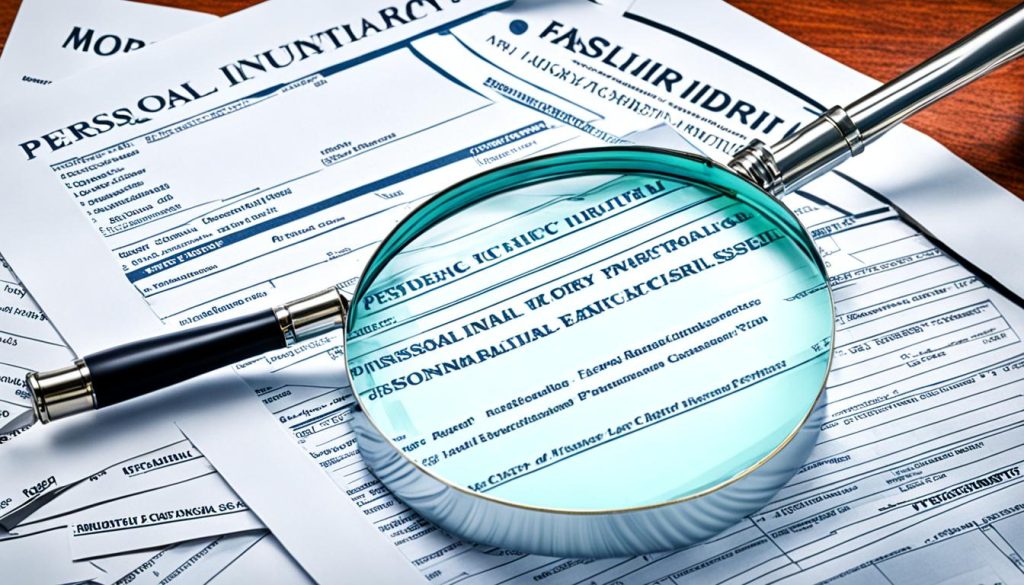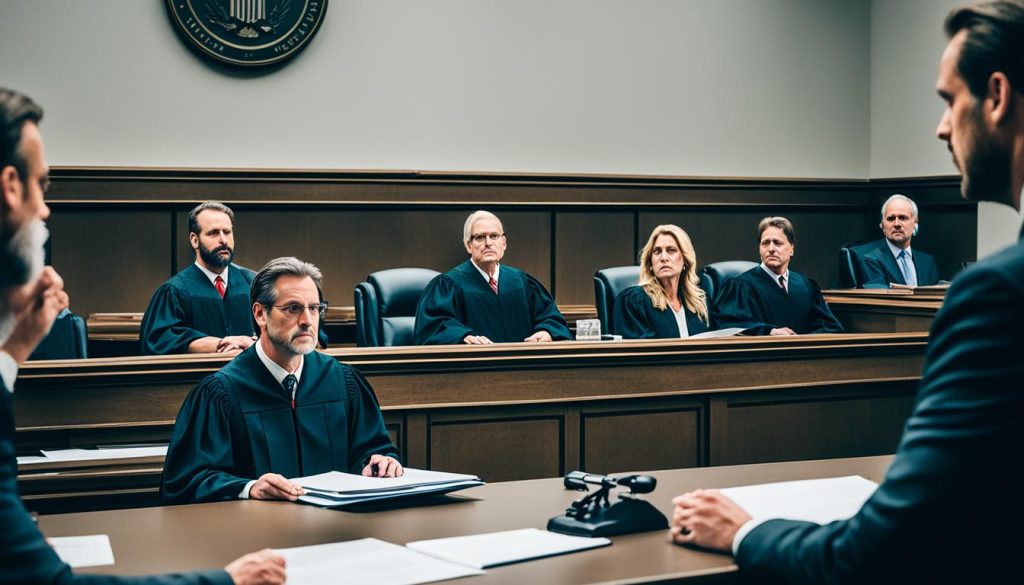If you’ve been injured in an accident, the legal system might seem overwhelming. But, knowing the steps in personal injury claims can help you make better choices and boost your chances of a good outcome. This guide will explain the legal process for personal injury claims in court, from the first meeting to the final decision.
The legal process for personal injury claims has several key stages. First, you must figure out if you need a lawyer and collect facts about the accident1. Often, smaller claims are settled outside court, which can speed up the process1.
After choosing an attorney, they will help build your case. They’ll gather documents and evidence to support your claims. This includes getting medical help, taking photos, and getting statements from witnesses2. Then, the lawyer will talk with the defendant’s insurance or legal team to try to settle1.
If settling fails, you’ll file a lawsuit and enter the discovery phase1. This phase involves both sides investigating each other’s claims and defenses. It can take from six months to a year1. Mediation might happen after discovery to help settle, but a trial could be needed if no agreement is reached.
The trial process is complex and can be delayed by various factors, like the court’s schedule1. If it goes to trial, a judge or jury will decide on who was at fault and how much damages the plaintiff should get1. Yet, most personal injury cases settle, showing a strong chance of a resolution for claimants1.
Key Takeaways
- The legal process for personal injury claims can take months to over a year, depending on the case’s complexity.
- Smaller claims are often settled out of court before a lawsuit is filed, potentially expediting the process.
- Hiring an attorney is crucial to build a strong case, gather evidence, and negotiate with insurance companies.
- The discovery phase, where both parties investigate each other’s claims, can last up to a year before a trial date is set.
- Most personal injury cases result in some form of settlement, indicating a high likelihood of resolution for claimants.
Understanding the Initial Consultation
The first meeting with a lawyer is key to seeing if you need a personal injury lawyer for your case. They will learn about your accident, your injuries, and the costs you’ve faced.
Since the late 1940s, courts have made it a rule to share all important facts between both sides3. There are three main ways to gather information: written questions, sharing documents, and taking testimony3. Asking someone to agree or deny facts is another way to move the case forward3. Testimony helps check the strength of the other side and how witnesses will act in court3.
Determining the Need for an Attorney
Your lawyer will tell you if your case is too complex for you to handle alone. They’ll explain why having a personal injury lawyer could be beneficial for your claim3.
Gathering Facts About the Accident
Your lawyer will ask for all the details about your accident during the first meeting. They want to know how you got hurt, the seriousness of your injuries, and the costs you’ve faced. This helps them decide the best way to move forward with your case.
Lawyers might call in expert witnesses for your case, especially if it looks like it could be costly3. They might also use certain legal moves to help your case along3.
Talking to a personal injury lawyer at the start is vital. It helps you understand your case and what steps to take next. With their help, you can make sure your rights are looked after and you get fair compensation.
| Key Takeaways |
|---|
| – The initial consultation is essential in determining the need for a personal injury lawyer and gathering facts about your accident. |
| – Attorneys may hire expert witnesses and use various motions to advance your case. |
| – The initial consultation is a critical step in understanding your case and ensuring you receive the compensation you deserve. |
If you’ve been in an accident and think you might need legal help, don’t hesitate to set up a free consultation with a personal injury lawyer. They can offer valuable advice and guide you through the legal steps.
“The initial consultation is a crucial step in understanding the complexities of your personal injury case and determining the best course of action.”
Hiring an Attorney and Building Your Case
If you need a lawyer for your personal injury case, the next step is signing a contract. This contract explains your relationship with the personal injury attorney, their duties, fees, and what documents you need for your case4.
After signing the contract, your attorney will look into your accident and collect all important documents and evidence. This makes sure your case is well-prepared. It also strengthens your attorney-client relationship and your negotiating power4.
Providing Documentation and Evidence
You’ll need to give your attorney a detailed story of the accident and any evidence documentation you have. This could be police reports, medical records, witness statements, and photos of the accident and your injuries4.
Attorney’s Investigation and Contact with Insurance Companies
Your attorney will use the info and evidence you provide to investigate your claim. They might talk to witnesses, get expert opinions, and find more documents. Then, they’ll talk to the insurance company of the person who hurt you to get a fair settlement4.
Working with an experienced personal injury attorney and helping build a strong case can really up your chances of getting the compensation you deserve45.
| Factors | Statistics |
|---|---|
| Percentage of personal injury cases settled out of court | Most personal injury cases settle before going to court5. |
| Duration for resolving a personal injury case | Experienced attorneys can give you a timeline for when your case might end5. |
| Contingency fee structure | Most personal injury lawyers work for a share of the settlement, only getting paid if you win5. |
| Attorney communication and point of contact | Knowing how often you’ll talk to your attorney and who to contact at their office helps you stay updated and feel secure about your case5. |
| Attorney specialization and experience | An attorney focused on personal injury law has the skills and knowledge you need for your case5. |
Not all personal injury lawyers are good in court, as many cases settle outside of court4. But trial lawyers are trained and have experience in court, which can help you get a better settlement4.
Insurance companies are more likely to offer a fair settlement if they think you might take it to trial4. Lawyers without trial experience might get lower offers, but trial attorneys with a good track record often get better offers4.
Having a trial lawyer in court is key to winning for their clients4. These lawyers prepare your case well, improve your negotiating position, give you ongoing legal help, make insurers respect them, and know the court system well4.
Our top lawyers have even been past presidents of the Trial Lawyers Association and are certified in civil trial law, so they know how to get you the most compensation4.

Negotiating a Settlement or Filing a Lawsuit
When you start a personal injury lawsuit, you face a big decision: whether to negotiate a settlement or go to court. This choice is key because it can change how long your case takes and its outcome6.
Demand Letter and Negotiations
Your lawyer will start by sending a demand letter to the party at fault or their insurance. This letter shares the details of your injuries, the damages you’ve faced, and a settlement amount you think is right6.
The other side might offer less money, and you’ll negotiate to find a middle ground. This negotiation can take time but usually ends in a quicker settlement than going to trial6.
Filing the Complaint and Defendant’s Response
If negotiations fail, your lawyer will file a complaint with the court. The other party has 20-30 days to answer7.
They might file motions to try to dismiss your case or reduce it. These motions can be a big hurdle in your lawsuit7.
After this, the case can get complex with discovery, motions, and possibly a trial. But, most personal injury cases, about 95%, settle before trial6.
| Step | Description | Duration |
|---|---|---|
| Discovery Phase | Evidence gathering and depositions | 3 to 12 months6 |
| Pre-trial Mediation | Attempt to reach settlement before trial | Approximately 70% success rate6 |
| Trial | Presentation of evidence and arguments | 1 day to 1 week on average6 |
Knowing about settlement negotiations and the litigation process helps you prepare for your personal injury lawsuit67.
The Discovery Phase and Pretrial Motions
After a personal injury lawsuit is filed, the discovery phase starts. This is when both sides collect evidence and conduct depositions. They also file motions with the court8. This process can take months to over a year, based on the case’s complexity9. During this time, trying to settle the case through mediation is common9.
Evidence Gathering and Depositions
The discovery phase includes interviews with witnesses, often through interrogatories and depositions9. This helps both sides get the information they need to build their cases8. Personal injury cases can have many parties, making the discovery phase longer9.
Filing Motions and Mediation
Attorneys may file pretrial motions to settle certain issues before trial9. These motions can end the case, like a motion to dismiss8. Settlement talks get more serious during the pre-trial phase, and many cases settle through mediation9.

Clients should expect their attorneys to prepare well before the discovery phase starts9. Pre-trial conferences are when the judge and attorneys talk about the case’s status and possible settlements9. If no settlement is reached, the case goes to trial. There, a jury decides on fault, liability, and damages10.
| Key Aspects of the Discovery Phase | Duration | Outcomes |
|---|---|---|
| Evidence Gathering and Depositions | Months to over a year | Allows both parties to build their cases |
| Filing Pretrial Motions | Varies | Can potentially conclude the case before trial |
| Mediation and Settlement Negotiations | Typically before trial | Many cases are settled out of court |
Throughout the discovery process and pretrial phase, attorneys are key in guiding clients and preparing them well9. The goal is to either settle fairly or present the case well at trial, based on the injury claim’s details10.
personal injury claims, court process, legal procedure
The legal process for personal injury claims in court is complex, with steps from the first meeting to possibly going to trial. The main goal is to collect evidence, negotiate a fair settlement, or present a strong case in court11.
Understanding the different tracks in the court process is key for personal injury claims. The small claims track is for claims up to $1,500, or $5,000 for car accident claims. The fast-track is for claims between $1,500 and $25,000, and the multi-track is for claims over $25,00011. The court sets strict deadlines for responding and providing information, and legal papers must include a ‘statement of truth’ to confirm the accuracy of the info11.
Following the court’s rules about giving out documents is crucial to avoid fines. The court takes claims exaggerated seriously and may fine accordingly11. Lawyers offer advice and support through a callback service, helping with the complex process of personal injury cases11.
| Court Track | Compensation Claim Range |
|---|---|
| Small Claims | Up to $1,500 (or $5,000 for RTA claims) |
| Fast-track | $1,500 to $25,000 |
| Multi-track | Exceeding $25,000 |
In the South Carolina Magistrates Court, the small claims limit is up to $7,500 for claims12. If a claim is over $7,500, it can still be filed in small claims court if both sides agree to the limit; otherwise, it goes to a higher court12. Lawyers can represent claimants in the South Carolina Magistrates Court, but it’s not required12.
In small claims court, showing evidence is key. This includes contracts, letters, photos of damage, expert opinions, and witness statements12. Knowing the statute of limitations is crucial, as it can be affected by certain situations12. The plaintiff must prove the harm done by the defendant and how much they need to be compensated12.
“Navigating the legal process for personal injury claims can be complex, but with the right guidance and attention to detail, you can ensure a fair and just outcome.”
Conclusion
The legal process for personal injury claims can seem complex. But, knowing the main steps is key to getting the compensation you need13. It’s vital to have an experienced personal injury lawyer by your side. They can protect your rights and help you through the legal steps.
From the first meeting with a lawyer to the final outcome, there are several stages. These include finding a lawyer, collecting evidence, negotiating settlements, and possibly going to trial14. Most personal injury cases settle outside of court15. But, it’s important to be ready for a trial. Trials can result in different types of damages, like compensatory and punitive damages.
Learning about personal injury claims, court process, and legal procedure helps you move through the system better. This can boost your chances of getting the right compensation for your injuries and losses131415.
FAQ
What are the key steps in the legal process for personal injury claims in court?
The legal process for personal injury claims in court has several key steps. First, you need to understand the initial consultation. Then, you hire an attorney and start building your case.
Next, you might negotiate a settlement or file a lawsuit. If not settled, you move to the discovery phase and pretrial motions. Finally, the case could go to court, where a judge or jury decides on liability and damages.
What happens during the initial consultation with a personal injury attorney?
The initial consultation is key to seeing if you need an attorney. The attorney will learn about your accident and injuries during this meeting. They’ll also look at the damages and costs.
They’ll tell you if your case is complex enough for legal help. They’ll explain the benefits of having an attorney work on your claim.
What are the steps involved in hiring a personal injury attorney and building your case?
After deciding you need legal help, you sign an attorney-client contract. This contract details the relationship, the attorney’s duties, fees, and what documents you need to provide.
Your attorney will then investigate your case thoroughly. They’ll collect all important documents and evidence. They’ll also start talking to the insurance company of the party at fault.
How does the process of negotiating a settlement or filing a lawsuit work?
Once you have all the evidence, your attorney sends a demand letter to the at-fault party or their insurance. This letter outlines your injuries and damages.
Then, they negotiate with the other side for a fair settlement. If a settlement can’t be reached, your attorney will file a lawsuit. This means submitting a complaint to the court, which the defendant must answer to.
What happens during the discovery phase and pretrial motions?
After filing the lawsuit, the discovery phase starts. Both sides gather evidence, take depositions, and file motions with the court. This process can take months to a year, depending on the case’s complexity.
During this time, parties might try to settle the case through mediation, a form of alternative dispute resolution.
Source Links
- Personal Injury Case Timeline
- Personal Injury Lawsuit Guide 2024
- The Process of a Personal Injury Lawsuit | Adam Kutner Injury Law
- Why It’s Important To Hire a Trial Attorney | Chaikin & Sherman
- Questions to Ask a Personal Injury Attorney Before Hiring One | News | PARRIS Law Firm
- Stages of a Personal Injury Case in Ohio | Amourgis & Associates
- The Friedmann Firm – Columbus Employment Lawyer
- What Happens in a Personal Injury Trial? – The Ryan Law Group
- Pre-trial and Discovery Phases in a Personal Injury Lawsuit
- A Step-by-Step Look at the Personal Injury Lawsuit Process
- Issuing Court Proceedings in Personal Injury Claims | Thompsons
- South Carolina Small Claims Magistrates Court Process
- 7 Key Steps in a Personal Injury Lawsuit
- What Happens If My Personal Injury Claim Goes To Court?
- Your Guide to Winning Personal Injury Claims: Understanding the Process – Guendelsberger Law Offices, LLP

